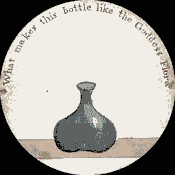There has always been something fantastical about animation to me. The word animation comes from the Latin Anima which translates as the breath of life. Animation is associated with energy, exuberance and liveliness. It is described technically as being a photographic technique in which successive 2D or 3D forms are captured and played back to create a moving image. Animated images have fascinated and beguiled man since the technique was created. The earliest known animation is not the thaumatrope or the zoetrope. It is believed that the earliest known animations can be found earthenware and ceramics from Greece and Iran. The thaumatrope, which became a popular Victorian toy, was invented in 1825 by Dr John Paris.
The thaumatrope worked due to persistence of vision. A card with for example a flower one side and vase on the other would have two pieces of string or elastic attached to either end which could be wound and when released cause the card to spin. when looked at whilst spinning, the human eye sees the first image, holds it and before it can release this image, the second enters its vision thus merging the images. A flip book works in the same way but with more images just like any piece of animation.

“Bouncing Totoro” 3D zoetrope by Studio Ghibli from : http://www.ghibliworld.com/museumspecial.html
One of my favourite things featured in the moving image lecture was the Studio Ghibli 3D Zoetrope. It features one of the most beloved Ghibli characters, Totoro. The “Bouncing Totoro” Zoetrope was made using 347 3D figurines and it took a year to complete. The 3D Zoetrope is a predecessor of William Horner’s Zoetrope. The fundamentals of drawn and 3D figurine animation have not changed greatly. It is the technology and the craft of animation that has evolved. Early lightning sketches animations didn’t have the realism that exists in modern animation.
Link to J. Stuart Blackton’s “The Humorous Phases of Funny Faces: http://www.youtube.com/watch?v=8dRe85cNXwg
Disney is very well-known for this but earlier is the work of Eadweard Muybridge, who was a very interesting character, was a pioneer of moving image. Even if this only came about due to a bet about whether or not when a horse runs if at one point all its hooves leave the ground. It turned out to be true though some mocked Muybridge’s discovery, it was true he had photographic evidence and an animation to stun the public. Muybridge’s books which contain series of successive images of people and animals are still highly influential to this day. If a little bit naked in places. I love a good animated movie, I am a huge studio Ghibli and Disney fan. I think I may actually prefer to look at Ghibli than Disney. Mostly because I don’t think I have ever seen a Ghibli film that was not visually stunning whereas some of the Disney sequels are somewhat lacking in the lustre that the first films had. Which is usually the way of sequels but it’s also rather disappointing. For example Mulan which had both a great plot and was visually stunning is rather let down by its sequel which doesn’t have the impeccable background and character art that the first movie had. Whereas Ghibli is just so lush. The scene in Spirited Away where Chihiro is running to the pig sheds through the flower bushes ( which I’m pretty sure are rhododendrons) is so vivid and so real, you really are pulled into that world. Like with a good book, a good animation draws you in and takes you into its world and a really good animation lingers in the memory. Persistence of vision.
References and Links to webpages that helped me write this post :
Muybridge, E. (2000) The Human Figure in Motion. Dover Publications Inc.
Eadweard Muybridge website. Available at : http://www.eadweardmuybridge.co.uk/
All of the above links were accessed on the 19.11.2013.





